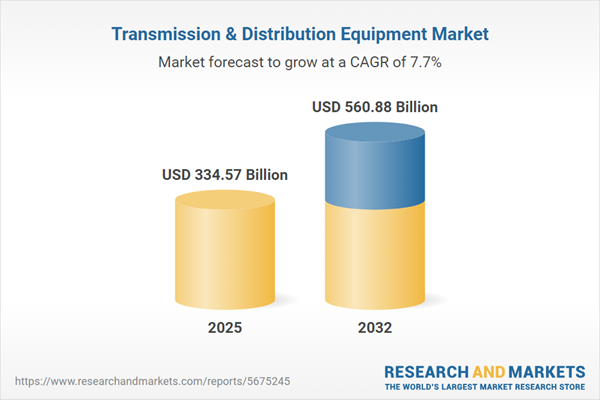Speak directly to the analyst to clarify any post sales queries you may have.
The transmission and distribution equipment market is evolving rapidly, driven by technology shifts, regulatory requirements, and new demands for electrical infrastructure resilience. Senior executives navigating this space must understand the complex interactions among equipment innovation, supply chain pressures, and sustainable asset strategies to keep pace with emerging opportunities.
Market Snapshot: Transmission and Distribution Equipment Market
The Transmission & Distribution Equipment Market grew from USD 310.95 billion in 2024 to USD 334.57 billion in 2025. It is projected to expand at a CAGR of 7.65%, reaching USD 560.88 billion by 2032. This market encompasses a critical suite of products and solutions underpinning modern electrical grids, including components essential for energy transfer and system reliability across global regions.
Scope & Segmentation
- Equipment Types: Includes capacitor banks, circuit breakers, distribution transformers, instrument transformers, power transformers, switches, switchgear, and voltage regulators.
- Insulation Types: Covers dry type and oil-filled insulation systems engineered for diverse operational environments.
- Installation Types: Addresses both indoor and outdoor installations suited to specific infrastructure needs and climatic conditions.
- Application Segments: Encompasses commercial, industrial, residential, and utility sectors, each with unique deployment scenarios.
- End User Categories: Serves industrial sectors such as manufacturing (including automotive, chemical, and food and beverage), mining, oil and gas, transportation, residential users, utilities, and commercial entities.
- Geographical Coverage: Provides in-depth analysis of Americas, Europe, Middle East & Africa, and Asia-Pacific markets, with dedicated regional and country-level insights.
- Key Industry Players: Profiles organizations such as ABB Ltd, Siemens Aktiengesellschaft, Schneider Electric SE, General Electric Company, Hitachi Energy Ltd, Mitsubishi Electric Corporation, Toshiba Energy Systems & Solutions Corporation, Eaton Corporation plc, Hyundai Electric & Energy Systems Co., Ltd, and CG Power and Industrial Solutions Limited.
Key Takeaways for Senior Decision-Makers
- Shifts toward digitization, renewable energy integration, and grid flexibility are revolutionizing how infrastructure is designed and maintained, impacting operational models and investment priorities.
- Supply chain resilience is increasingly critical as manufacturers and developers respond to evolving sourcing challenges and localized production requirements.
- Progress in asset health monitoring, lifecycle management, and circular economy practices is shaping equipment innovation and offering new avenues for operational efficiency and sustainability.
- Variations in regional regulatory landscapes, utility business models, and infrastructure renewal cycles require tailored strategies for market entry and portfolio adaptation.
- Collaborative efforts between equipment manufacturers, technology providers, and service specialists are resulting in improved interoperability and faster deployment of advanced grid solutions.
- Growth in industrial and commercial end-use sectors drives demand for customized service agreements and benchmarking frameworks to support critical power processes.
Tariff Impact: Navigating U.S. Import Duties and Global Sourcing Challenges
The 2025 introduction of tariffs on imported transmission and distribution equipment components in the United States has placed pressure on procurement and increased complexity in project development. Senior decision-makers are responding by revising sourcing strategies, seeking alternative suppliers, and renegotiating supply contracts. These steps, along with the exploration of new material options and localized manufacturing, aim to mitigate rising costs while maintaining delivery schedules and quality standards.
Methodology & Data Sources
This report relies on qualitative interviews with senior industry stakeholders and frontline technicians, combined with analysis of secondary sources such as technical journals, regulatory filings, and trade publications. Data triangulation validates market trends, while comparative evaluations of product portfolios and recent project case studies ensure a comprehensive view. Analytical frameworks, including value chain mapping and scenario analysis, provide additional rigor for accurate and actionable findings.
Why This Report Matters
- Enables executives to align investment and procurement strategies with shifting technology and regulatory environments in the transmission and distribution equipment market.
- Provides targeted regional and application-focused insights to support tailored market-entry, partnership, and risk mitigation decisions.
- Empowers industry leaders to anticipate operational, supply chain, and sustainability shifts, leading to more informed and resilient infrastructure planning.
Conclusion
The transmission and distribution equipment sector is adapting to increased complexity and evolving requirements. This report equips decision-makers with the intelligence needed to capitalize on market changes, enhance infrastructure strategies, and secure long-term operational performance.
Additional Product Information:
- Purchase of this report includes 1 year online access with quarterly updates.
- This report can be updated on request. Please contact our Customer Experience team using the Ask a Question widget on our website.
Table of Contents
3. Executive Summary
4. Market Overview
7. Cumulative Impact of Artificial Intelligence 2025
Companies Mentioned
The companies profiled in this Transmission & Distribution Equipment market report include:- ABB Ltd
- Siemens Aktiengesellschaft
- Schneider Electric SE
- General Electric Company
- Hitachi Energy Ltd
- Mitsubishi Electric Corporation
- Toshiba Energy Systems & Solutions Corporation
- Eaton Corporation plc
- Hyundai Electric & Energy Systems Co., Ltd
- CG Power and Industrial Solutions Limited
Table Information
| Report Attribute | Details |
|---|---|
| No. of Pages | 199 |
| Published | November 2025 |
| Forecast Period | 2025 - 2032 |
| Estimated Market Value ( USD | $ 334.57 Billion |
| Forecasted Market Value ( USD | $ 560.88 Billion |
| Compound Annual Growth Rate | 7.6% |
| Regions Covered | Global |
| No. of Companies Mentioned | 11 |









